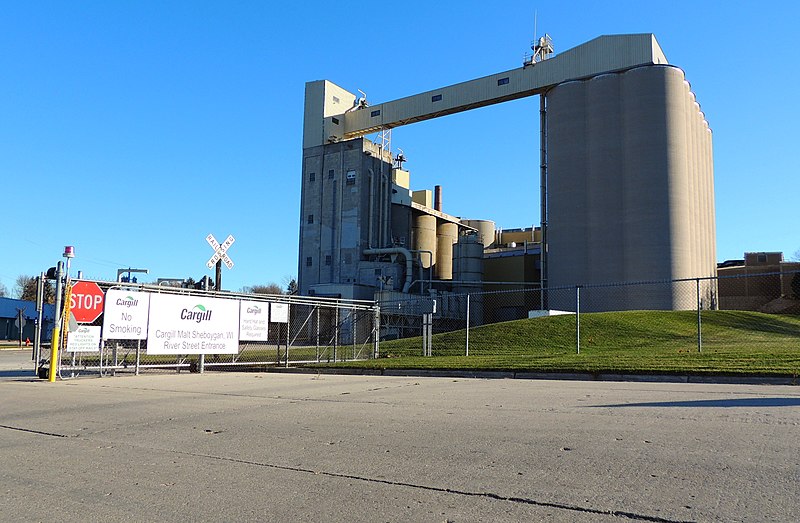
A cargo ship equipped with revolutionary, large-scale wind-powered sails, designed in the UK, has embarked on its maiden journey.
Cargill, the shipping company that has chartered the vessel, envisions that this technology will steer the industry towards a more environmentally friendly future.
The innovative WindWings sails, which resemble wings, aim to reduce fuel consumption and thus the carbon footprint of shipping.
Shipping contributes to around 2.1% of global carbon dioxide (CO2) emissions, an estimate of its environmental impact.
The Pyxis Ocean's initial voyage will span from China to Brazil, serving as the first real-world trial for this wind-wing technology.
When the ship is docked, these sails can be folded down; however, they are unfurled when the ship is at sea. These sails, standing at 123 feet (37.5 meters) tall, are constructed from the same durable material as wind turbines.
Harnessing wind to propel a vessel, rather than solely relying on its engines, could potentially reduce a cargo ship's total emissions over its lifespan by approximately 30%.
Jan Dieleman, the President of Cargill Ocean Transportation, stated that the industry is on a path toward decarbonization. He acknowledged that while there isn't a single solution, this technology showcases the industry's rapid evolution.
Dieleman shared with the BBC, "About five or six years ago, if you asked individuals in the shipping industry about decarbonization, they would express skepticism and indicate that it's a formidable challenge. Today, the narrative has transformed entirely, and everyone is genuinely committed to their role. The challenge lies in determining how we'll collectively achieve this goal."
"We, as one of the major players, have embraced the role of underwriting some of the risk, taking on experimentation, and driving the industry forward," he emphasized.
The Pyxis Ocean is projected to reach its destination in roughly six weeks. The underpinning technology stems from a much faster concept.
The innovation originated from BAR Technologies, a UK company that spun off from Sir Ben Ainslie's 2017 America's Cup team, which is sometimes referred to as the 'Formula One of the seas'.
John Cooper, the head of BAR Technologies and a former employee of the Formula One team McLaren, asserted, "Although this project has evolved gradually, it possesses the most significant potential for global impact."
Cooper believes this journey marks a turning point for the maritime sector.
"I anticipate that by 2025, half of all newly constructed ships will incorporate wind propulsion," he confidently stated.
"The basis for my optimism is the savings we've realized—approximately one-and-a-half tonnes of fuel per day. When four wings are utilized on a vessel, this amounts to six tonnes of fuel saved, which translates to a reduction of 20 tonnes of CO2 per day. The figures are staggering."
While the concept hails from the UK, the wings themselves are manufactured in China. Cooper noted that the absence of government incentives to reduce the cost of imported steel prevents the company from manufacturing the wings domestically.
"It's regrettable; I would have liked to produce them in the UK," he expressed to the BBC.
Maximizing Wind Power for Sustainable Shipping
Experts consider wind power a promising avenue to explore as the shipping industry strives to curtail the approximately 837 million tonnes of CO2 it releases annually.
In July, the industry committed to achieving net-zero emissions of planet-warming gases "by or around 2050," a pledge criticized by some as insufficient.
Dr. Simon Bullock, a shipping researcher at the Tyndall Centre at the University of Manchester, affirmed, "Wind power can make a significant impact." He emphasized that while cleaner fuels will require time to develop, focusing on operational measures for existing vessels, such as retrofitting sails, kites, and rotors, is essential.
"In the long run, we need zero-carbon fuels for all ships; however, in the interim, optimizing every journey's efficiency is imperative. Slower speeds also play a pivotal role in the solution," he informed the BBC.
Stephen Gordon, Managing Director at maritime data firm Clarksons Research, concurred that wind-related technologies are gaining momentum.
He elaborated, "Over the past 12 months, we have witnessed the number of ships using this technology double."
"However," he noted, "this growth stems from a modest starting point. In the international shipping fleet and the new-build order book, which comprises over 110,000 vessels, we possess records for fewer than 100 vessels currently incorporating wind-assisted technology."
Even if this number increases significantly, wind-based technology may not be suitable for every vessel, especially when sails interfere with container unloading.
"The shipping industry lacks a clear pathway to decarbonization, and given the magnitude of the challenge and the diversity of the global shipping fleet, a single solution is unlikely in the short or medium term," Gordon projected.
In contrast, John Cooper of BAR Technologies expressed optimism, envisioning a bright future for wind wings.
He also finds satisfaction in the idea of the industry returning to its roots.
"The engineers might not be fond of it, but I often say it's a return to the past," he remarked.
"The advent of large combustion engines disrupted the trade routes and sailing routes. Now, we're endeavoring to reverse this trend, even if only partially." Photo by Asher Heimermann, Wikimedia commons.




































